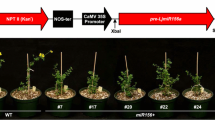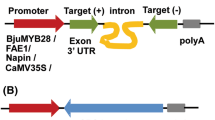Abstract
Asynchronous pod-shatter results in significant yield losses in canola. SHATTERPROOF1 (SHP1) and SHATTERPROOF2 (SHP2) regulate pod shatter in Brassicaceae. This study describes the potential of an artificial RNA (amiRNA)-based approach for redundant silencing of SHP1/SHP2 homologs in Brassicas for introducing shatter resistance. After surveying the natural variation in Brassica SHP homologs, amiR-bnashp1 and amiR-bnashp2 were designed and processed from miR319a precursor in N. benthamiana. Analysis of thermodynamic interaction between amiRNAs and SHP1/SHP2 homologs predicted high binding energy for amiR-bnashp2 [total free energy of binding (TFEB): −23.54 kcal/mol] and not for amiR-bnashp1 (TFEB: 6.01 kcal/mol). As predicted, agro-co-infiltration assay validated amiR-bnashp2-mediated cleavage of SHP1 and SHP2 homologs from B. napus, B. juncea and A. thaliana, while amiR-bnashp1 failed to direct cleavage of these homologs. In conclusion, for trait manipulation in polyploid genomes deployment of amiRNAs is suggested to silence redundant genes. Furthermore, an a priori knowledge on transcriptome potential of genome concerned is a prerequisite for predicting efficiency and specificity of target selection by amiRNA(s).




Similar content being viewed by others
References
Adams KL (2007) Evolution of duplicate gene expression in polyploid and hybrid plants. J Hered 98:136–141
Araújo P, Cesarino I, Carmello-Guerreiro SM, Dornelas MC (2013) Citrus sinensis L. Osbeck orthologs of FRUITFULL and SHATTERPROOF are differentially expressed during fruit development. Plant Growth Regul 70:1–13
Babula D, Kaczmarek M, Barakat A, Delseny M, Quiros CF, Sadowski J (2003) Chromosomal mapping of Brassica oleracea based on ESTs from Arabidopsis thaliana: complexity of the comparative map. Mol Genet Genomics 268:656–665
Boss PK, Viver M, Matsumoto S, Dry IB, Thomas MR (2001) A cDNA from grapevine (Vitis vinifera L.), which shows homology to AGAMOUS and SHATTERPROOF, is not only expressed in flowers but also throughout berry development. Plant Mol Biol 45:541–553
Chen C, Radzon DA, Broomer AJ, Jhou Z, Lee DH, Nguyen JT et al (2005) Real time quatification of miRNAs by stem-loop RT PCR. Nucl Acid Res 33:e179
De Felippes FF, Weigel D (2010) Transient assays for the analysis of miRNA processing and function. Methods Mol Biol 592:255–264
Drummond AJ, Rambaut A (2007) BEAST: Bayesian evolutionary analysis by sampling trees. BMC Evol Biol 7:214–221
Favaro R, Pinyopich A, Battaglia R, Kooiker M, Borghi L, Ditta G, Yanofsky MF, Kater MM, Colombo L (2003) MADS-Box protein complexes control carpel and ovule development in Arabidopsis. Plant Cell 15:2603–2611
Flanagan CA, Hu Y, Ma H (1996) Specific expression of the AGL1 MADS-box gene suggests regulatory functions in Arabidopsis gynoecium and ovule development. Plant J 10:343–353
Hall TA (1999) BioEdit: a user-friendly biological sequence alignment editor and analysis program for Windows 95/98/NT. Nucl Acids Symp Ser 41:95–98
Kertesz M, Iovino N, Unnerstall U, Gaul U, Segal E (2007) The role of site accessibility in microRNA target recognition. Nat Genet 39:1278–1284
Koch MA, Haubold B, Mitchell-Olds T (2001) Molecular systematics of the Brassicaceae: evidence from coding plastidic matK and nuclear Chs sequences. Am J Bot 88:534–544
Lagercrantz U (1998) Comparative mapping between Arabidopsis thaliana and Brassica nigra indicates that Brassica genomes have evolved through extensive genome replication accompanied by chromosome fusions and frequent rearrangements. Genetics 150:1217–1228
Lan TH, DelMonte TA, Reischmann KP, Hyman J, Kowalski SP, McFerson J, Kresovich S, Paterson AH (2000) An EST-enriched comparative map of Brassica oleracea and Arabidopsis thaliana. Genome Res 10:776–788
Liljegren S, Ditta G, Eshed Y, Savidge B, Bowman J, Yanofsky M (2000) SHATTERPROOF MADS-box genes control seed dispersal in Arabidopsis. Nature 404:766–770
Liljegren SJ, Roeder AH, Kempin SA, Gremski K, Østergaard L, Guimil S, Reyes DK, Yanofsky MF (2004) Control of fruit patterning in Arabidopsis by INDEHISCENT. Cell 116:843–853
Lu S, Du X, Lu W, Chong K, Meng Z (2007) Two AGAMOUS-like MADS-box genes from Taihangia rupestris (Rosaceae) reveal independent trajectories in the evolution of class C and class D floral homeotic functions. Evol Dev 9:92–104
Lysak MA, Koch MA, Pecinka A, Schubert I (2005) Chromosome triplication found across the tribe Brassicacae. Genome Res 15:516–525
MacLeod J (1981) Harvesting in oilseed rap, in Oilseed rape book. In: Green C (ed) A manual for growers, farmers and advisors. Cambridge Agricultural Publishing, Cambridge, pp 107–120
Meng L, Feldman L (2010) A rapid TRIzol-based two-step method for DNA-free RNA extraction from Arabidopsis siliques and dry seeds. Biotechnol J 5:183–186
Muckstein U, Tafer H, Hackermuller J, Bernhart SH, Stadler PF, Hofacker IL (2006) Thermodynamics of RNA–RNA binding. Bioinformatics 22:1177–1182
Nanni L, Bitocchi E, Bellucci E, Rossi M, Rau D, Attene G, Gepts P, Papa R (2011) Nucleotide diversity of a genomic sequence similar to SHATTERPROOF (PvSHP1) in domesticated and wild common bean (Phaseolus vulgaris L.). Theor Appl Genet 123:1341–1357
Osborn TC (2004) The contribution of polyploidy to variation in Brassica species. Physiol Plant 121:531–536
Ossowski S, Fitz J, Schwab R, Riester M, Weigel D, personal communication
Otto SP, Whitton J (2000) Polyploid incidence and evolution. Annu Rev Genet 34:401–437
Parkin IA, Gulden SM, Sharpe AG, Lukens L, Trick M, Osborn TC, Lydiate DJ (2005) Segmental structure of the Brassica napus genome based on comparative analysis with Arabidopsis thaliana. Genetics 171:765–781
Pinyopich A, Ditta GS, Savidge B, Liljegren SJ, Baumann E, Wisman E, Yanofsky MF (2003) Assessing the redundancy of MADS-box genes during carpel and ovule development. Nature 424:85–88
Rajani S, Sundaresan V (2001) The Arabidopsis myc/bHLH gene ALCATRAZ enables cell separation in fruit dehiscence. Curr Biol 11:1914–1922
Sablok G, Pérez-Quintero AL, Hassan M, Tatarinova TV, López C (2011) Artificial microRNAs (amiRNAs) engineering - On how microRNA-based silencing methods have affected current plant silencing research. Biochem Biophys Res Commun 406:315–319
Sankoff D, Zheng C, Wang B (2012) A model for biased fractionation after whole genome duplication. BMC Genom 13(Supp I):S8
Savidge B, Rounsley SD, Yanofsky MF (1995) Temporal relationship between the transcription of two Arabidopsis MADS box genes and the floral organ identity genes. Plant Cell 7:721–733
Schwab R, Ossowski S, Riester M, Warthmann N, Weigel D (2006) Highly specific gene silencing by artificial microRNAs in Arabidopsis. Plant Cell 18:1121–1133
Spence J, Vercher Y, Gates P, Harris N (1996) Pod shatter in Arabidopsis thaliana, Brassica napus and B. juncea. J Microsc 181:195–203
Tani E, Polidoros AN, Tsaftaris AS (2007) Characterization and expression analysis of FRUITFULL- and SHATTERPROOF-like genes from peach (Prunus persica) and their role in split-pit formation. Tree Physiol 27:649–659
Van der Linden CG, Vosman B, Smulders MJ (2002) Cloning and characterization of four apple MADS-box genes isolated from vegetative tissue. J Exp Bot 53:1025–1036
Veitia RA (2005) Gene dosage balance: deletions, duplications and dominance. Trends Genet 21:33–35
Vrebalov J, Pan IL, Arroyo AJ, McQuinn R, Chung M, Poole M, Rose J, Seymour G, Grandillo S, Giovannoni J et al (2009) Fleshy fruit expansion and ripening are regulated by the tomato SHATTERPROOF gene TAGL1. Plant Cell 21:3041–3062
Ziolkowski PA, Kaczmarek M, Babula D, Sadowski J (2006) Genome evolution in Arabidopsis/Brassica: conservation and divergence of ancient rearranged segments and their breakpoints. Plant J 47:63–74
Zuker M, Stiegler P (1981) Optimal computer folding of large RNA sequences using thermodynamics and auxiliary information. Nucleic Acid Res 9:133–148
Acknowledgments
This work was supported by grants (BT/PR10071/AGR/36/31/2007 and BT/PR628/AGR/36/674/2011) received from Department of Biotechnology, Govt. of India. The authors thank Dr. Sandip Das for offering valuable suggestions. Plasmid pRS300 was received as a kind gift from Prof. Detlef Weigel. Financial assistance as SRF to Priyanka Dhakate from Council of Scientific and Industrial Research and to S.M. Shivaraj from Department of Biotechnology, Govt. of India is gratefully acknowledged. Infrastructural support from TERI and TERI University are duly acknowledged.
Author information
Authors and Affiliations
Corresponding author
Additional information
Communicated by E. Schleiff.
Electronic supplementary material
Below is the link to the electronic supplementary material.
Rights and permissions
About this article
Cite this article
Dhakate, P., Shivaraj, S.M. & Singh, A. Design of artificial miRNA for redundant silencing of Brassica SHP1 and SHP2: transient assay-based validation of transcript cleavage from polyploid Brassicas. Acta Physiol Plant 36, 2125–2135 (2014). https://doi.org/10.1007/s11738-014-1589-6
Received:
Revised:
Accepted:
Published:
Issue Date:
DOI: https://doi.org/10.1007/s11738-014-1589-6




